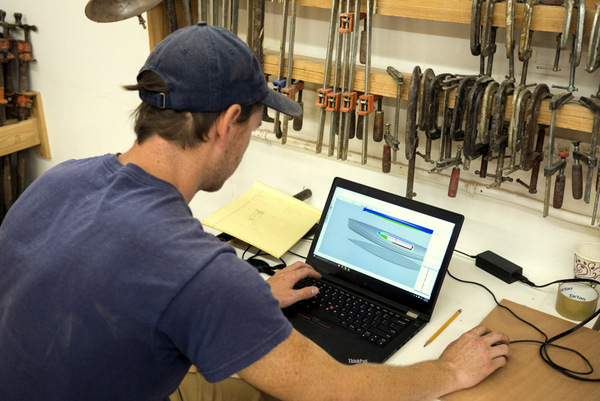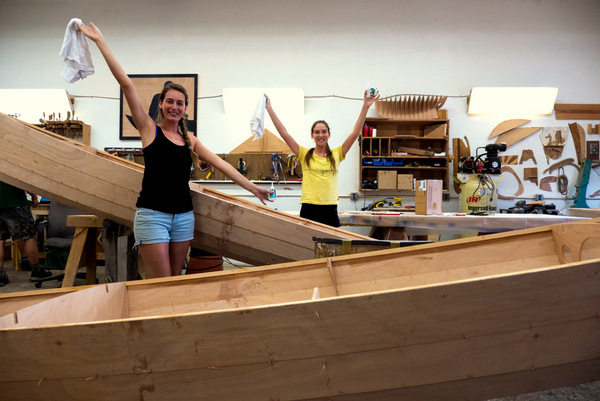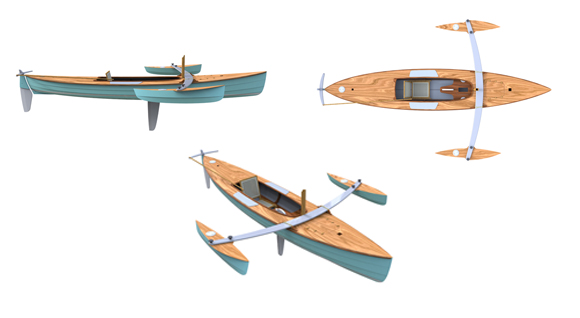
In the summer of 2016 Chesapeake Light Craft partnered with the filmmaking team Waterlust to design and build a pair of 17-foot sailing canoes. Waterlust - Patrick Rynne, Fiona Graham, Laura Graham, and Jennah Caster - then embarked on a 1,000-mile expedition down the Intracoastal Waterway (ICW) in the finished canoes, from Norfolk to their home base in Miami, Florida.
 The boats were drawn for Waterlust by CLC's own Dillon Majoros. The design takes its cues from classic sailing canoes of the late 19th century. Dillon has added a higher volume hull with fuller ends for increased carrying capacity, stability, and performance under sail. The hull design includes watertight compartments fore and aft, watertight storage forward of cockpit, and stowage bins port and starboard in the cockpit that double as support rails for the seat. The cockpit extends under the aft deck, and may be used as a berth for the crew. The boat is powered by a yawl rig, which is traditional to the type and easy to manage, too.
The boats were drawn for Waterlust by CLC's own Dillon Majoros. The design takes its cues from classic sailing canoes of the late 19th century. Dillon has added a higher volume hull with fuller ends for increased carrying capacity, stability, and performance under sail. The hull design includes watertight compartments fore and aft, watertight storage forward of cockpit, and stowage bins port and starboard in the cockpit that double as support rails for the seat. The cockpit extends under the aft deck, and may be used as a berth for the crew. The boat is powered by a yawl rig, which is traditional to the type and easy to manage, too.
Among the more unique features of the design is an integrated Hobie Mirage Drive for auxiliary power. This drops into a trunk in the cockpit.
Kits for these proven sailing canoes are available now.
Based in Miami, FL, Waterlust is a unique venture which combines marine science, sport, and art, and then makes incredible videos about it. Inspired by their experience creating a film about the 2015 Race to Alaska, the Waterlust team wanted to do something of a similar scale but with a less frenetic pace than a race and less challenging to film than an offshore race through the wilderness. They opted for a coastal expedition. CLC's reputation for innovative smallcraft designs seemed like a good fit for their itinerary, and a partnership was formed.

In July 2016 a matched pair of 17-foot sailing canoes were built, finished, and rigged in a marathon three weeks at CLC's factory in Annapolis, Maryland.
The Waterlust crew set off for Miami in August 2016, cameras rolling. The long coastal trip was a perfect trial for the new design. They minded the weather, as sailing canoe voyagers do, including the menacing Hurricane Hermine, but encountered few issues during the trip.
Dillon's elegantly proportioned design generated an avalanche of mail from small boat fanatics. There have been expedition-worthy sailing canoe designs for upwards of 150 years, but the combination of features that Dillon worked into this new design expand its appeal. The Hobie Mirage Drive, in particular, is a remarkable feature. GPS speeds upwards of 6 knots were recorded using the pedal drive alone. But perhaps the best thing about it is the ergonomic arrangement of the cockpit: "motorsailing" with the Mirage Drive is as natural as walking. (For pure sailing, the Mirage Drive can be lifted out of its watertight trunk and stowed in the cockpit.)
It is even possible for a single adult to sleep in the cockpit.
By pedantic definition the Waterlust Sailing Canoe is a cat-ketch, though in spirit it is a cat-yawl. (The mainsail provides most of the drive while the mizzen adds balance and offwind power.) Those living in windy conditions may opt to set the main mast a bit further back and eliminate the mizzen. The boats are fast and close-winded under sail. Stability is surprisingly solid, though as in any sailing canoe you'll not want to cleat the mainsheet!
Construction is stitch-and-glue using CLC's LapStitch™ process. Computer-cut marine plywood panels are stitched together, forming the hull in a matter of hours. Sub-assemblies such as the Mirage Drive trunk and daggerboard trunk are built on the bench and dropped into the hull to be secured with epoxy fillets. Plenty of fiberglass cloth reinforcement and saturating coats of epoxy yield a stiff, rugged hull that weighs just about 80lbs. Fully rigged, the Waterlust Sailing Canoe weighs about 115 pounds.
The first two Waterlust Sailing Canoes were cut on our CNC machine here at CLC. Dillon made minor corrections and improvements as the project unfolded, so that we are now able to cut and ship kits to be built at home. (Plans and patterns for scratch-builders have not yet been drawn.)
We're recommending this design for folks who have built boats using the stitch-and-glue method. Dillon has created a comprehensive 28-page illustrated assembly guide, which you can download from this page to review. For experienced builders this will be an absolutely straightforward boatbuilding project. (First-timers will want to start with a kit that has one of our massively-detailed, 100+ page build guides.)
The base hull kit includes all of the computer-cut marine plywood parts, plus milled cypress and mahogany for stringers and trim. Copper wire, epoxy, and fiberglass, are also included. The sailing component package includes rudder, daggerboard, six spars, and both sails, white in color with 1 reef. (Hardware is sold separately for all versions.)
Waterlust Sailing Canoe Outrigger Package:
for package details, click here.
